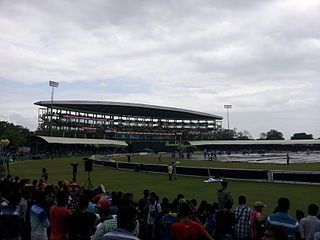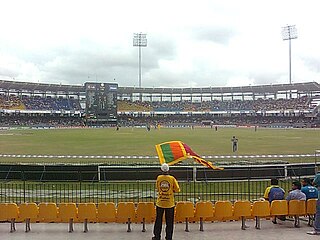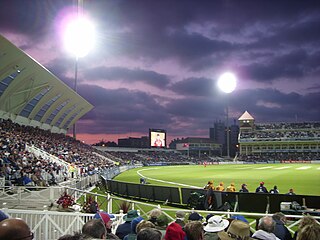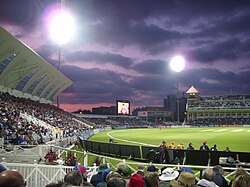
Trent Bridge Cricket Ground is a cricket ground mostly used for Test, One-Day International and county cricket located in West Bridgford, Nottinghamshire, England, just across the River Trent from the city of Nottingham. Trent Bridge is also the headquarters of Nottinghamshire County Cricket Club. As well as international cricket and Nottinghamshire's home games, the ground has hosted the Finals Day of the Twenty20 Cup twice and will host the final of the One-Day Cup between 2020 and 2024.
The NatWest Pro40 League was a one-day cricket league for first-class cricket counties in England and Wales. It was inaugurated in 1999, but was essentially the old Sunday League retitled to reflect large numbers of matches being played on days other than Sunday.

The Riverside Ground, known for sponsorship reasons as the Seat Unique Riverside, is a cricket venue in Chester-le-Street, County Durham, England. It is home to Durham County Cricket Club, and has also hosted several international matches.

Rangiri Dambulla International Cricket Stadium is a 16,800-seat cricket stadium in Sri Lanka. It is situated in the Central Province, close to Dambulla on a 60-acre site leased from the Rangiri Dambulla Temple. it is the first and only International cricket ground in the dry zone of Sri Lanka. The stadium is built overlooking the Dambulla Tank (reservoir) and the Dambulla Rock.

Edgbaston Cricket Ground, also known as the County Ground or Edgbaston Stadium, is a cricket ground in the Edgbaston area of Birmingham, England. It is home to Warwickshire County Cricket Club and its T20 team Birmingham Bears. Edgbaston has also been the venue for Test matches, One-Day Internationals and Twenty20 Internationals. Edgbaston has hosted the T20 Finals Day more than any other cricket ground. Edgbaston is the main home ground for the Birmingham Phoenix in The Hundred competition from 2021.

The County Ground in Chelmsford, Essex, has been the official home ground of Essex County Cricket Club since 1967. It is currently known as The Cloud County Ground for sponsorship reasons. It has been used for first-class cricket since 1925 and List A matches since 1969. The capacity is 6,500, mostly in single-tier seating with a single double-tiered stand. The pavilion was completed in the 1970s.

The Daren Sammy Cricket Ground, previously the Beausejour Cricket Ground, is a cricket ground located near Gros Islet, Saint Lucia standard seating capacity of 15,000. It was completed in 2002 and currently accommodates 13,000 spectators.

The R. Premadasa Cricket Stadium(RPS) (Sinhala: ආර්. ප්රේමදාස ක්රීඩාංගනය, Tamil: ஆர். பிரேமதாச அரங்கம்; formerly known as Khettarama Stadium) is a cricket stadium on Khettarama Road, in the Maligawatta suburb of Colombo, Sri Lanka. The stadium was, before June 1994, known as the Khettarama Cricket Stadium and is today one of the main venues where the Sri Lankan cricket team play, having hosted more than 100 one-day international matches. It is the largest stadium in Sri Lanka with a capacity of 38,000 spectators. It has hosted the 2012 ICC World Twenty20 final between Sri Lanka and West Indies; the 2002 ICC Champions Trophy final between Sri Lanka and India and first semi-final of the 2011 ICC Cricket World Cup between Sri Lanka and New Zealand. This was where the highest Test score in history was recorded; 952 by Sri Lanka against India. With capacity exceeding Lord's in England, the stadium is known as the "home of Sri Lankan cricket".

The Providence Stadium or Guyana National Stadium is a sports stadium in Guyana, replacing Bourda as the national stadium. The stadium was built specifically to host Super Eight matches in the 2007 Cricket World Cup held in March and April 2007.

The Sher-e-Bangla National Cricket Stadium, also called Mirpur Stadium, is an International cricket ground at Mirpur, in Dhaka, the capital of Bangladesh. Located 10 kilometres from Mirpur city centre, the ground holds approximately 25,000 people and is named after the Bengali statesman A. K. Fazlul Huq, who was accorded the title Sher-e-Bangla.

Zahur Ahmed Chowdhury Stadium, abbreviated as ZAC Stadium or ZACS and previously known as Bir Shrestha Shahid Ruhul Amin Stadium, is a cricket stadium located in the port city of Chattogram, in south-eastern Bangladesh. It became a Test cricket venue on 27 February 2006 when it hosted a Test match between Sri Lanka and Bangladesh. It hosted two group matches of the 2011 ICC Cricket World Cup. It has a seating capacity of around 20,000. The stadium was initially named after Zahur Ahmad Chowdhury on 17 June 2001 by the Bangladesh Awami League government. It was renamed after Ruhul Amin by the Bangladesh Nationalist Party government in October 2001. It was returned to its original name in 2009 of Zahur Ahmed Chowdhury Stadium after Bangladesh Awami League returned to power.

A floodlight is a broad-beamed, high-intensity artificial light. They are often used to illuminate outdoor playing fields while an outdoor sports event is being held during low-light conditions. More focused kinds are often used as a stage lighting instrument in live performances such as concerts and plays.

Cricket 07 is a 2006 cricket simulation computer game developed by EA Canada and HB Studios and published by EA Sports. It is available for Microsoft Windows and PlayStation 2. The game was released on 26 November 2006 in Europe and in Australia on 14 November 2006. The cover art for Cricket 07 features English cricketer Andrew Flintoff. This is the last cricket game published by EA Sports. This game has garnered massive popularity among the cricket playing nations and many patches have been produced to update the game.

The Chester Road North Ground, often referred to simply as Chester Road or Kidderminster, is a cricket ground in Kidderminster, Worcestershire, England. It is the home of Kidderminster Cricket Club, and is currently used for Worcestershire County Cricket Club's Second XI matches. It was opened in 1870.

Captain Roop Singh Stadium, is a cricket ground in Gwalior, Madhya Pradesh. The stadium has hosted 12 ODI matches, the first one was played between India and West Indies on 22 January 1988.
The 2008 English cricket season was the 109th in which the County Championship had been an official competition. Four regular tournaments were played: The LV County Championship (first-class), Friends Provident Trophy, NatWest Pro40 League and the Twenty20 Cup (T20). All four tournaments featured the eighteen classic county cricket teams, although the Friends Provident Trophy also featured sides from Ireland and Scotland.

The Dubai International Stadium, formerly known as the Dubai Sports City Cricket Stadium, is a multi-purpose stadium in Dubai, United Arab Emirates. It is mainly used for cricket and is one of the three main cricket stadiums in the country, the other two being Sharjah Cricket Stadium in Sharjah and Sheikh Zayed Cricket Stadium in Abu Dhabi. It has seating capacity for 25,000 spectators, but is expandable to accommodate 30,000 spectators. It is a part of the Dubai Sports City in Dubai. The architect of this project was the Canadian architect, Awsam Matloob. The stadium was one of the dedicated venues for the 2021 ICC Men's T20 World Cup, it hosted Semi Final 2 and the Final on November 11, 2021 and November 14, 2021 respectively.

Day/night cricket, also known as floodlit cricket, is a cricket match that is played either totally or partially under floodlights in the evening. The first regular cricket to be played under floodlights occurred during World Series Cricket, unsanctioned by the International Cricket Council (ICC), attracting large crowds to see some of the world's best players compete in Australia and the West Indies. In 1979, when the ICC and World Series Cricket came to an understanding, the first floodlit One Day International was played, also in Australia. Floodlit cricket has since been played around the world, although England was slow to take it up due to their climate. Floodlit first-class cricket was first played in 1994, when the concept was tried during the Sheffield Shield. Day/night cricket is now commonplace in one-day cricket and Twenty20 cricket. For instance, all 27 matches in the 2014 ICC World Twenty20 were day/night matches, as were most matches in the 2011 Cricket World Cup.
The Lahore City Cricket Association Ground is a cricket ground located opposite the Gaddafi Stadium in Lahore, Pakistan. This ground is used for domestic First-class cricket, List A cricket and Twenty20 cricket matches. The acting President of Lahore City Cricket Association is Mr. Aizad Hussain Sayid. From 1980 to November 2012, 265 First-class cricket matches, 105 List A cricket matches and 12 Twenty20 cricket matches were played on this ground.
The One-Day Cup is a fifty-over limited overs cricket competition for the England and Wales first-class counties. It began in 2014 as a replacement for the ECB 40 tournament, which ran from 2010 to 2013. In contrast to its 40-over predecessor, the number of overs per innings was set at 50 to bring the competition in line with One-Day Internationals.


















